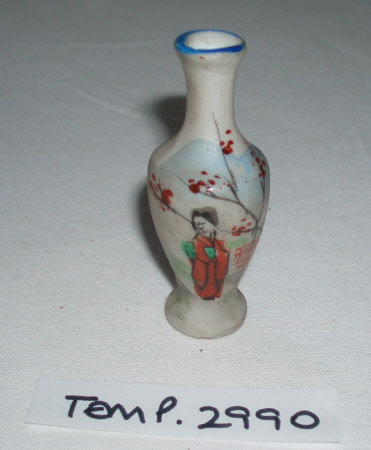Doll's house vase
Category
Dolls' houses and furnishings
Date
Unknown
Materials
Ceramic
Measurements
55 mm (height)
Order this imageCollection
Sudbury Hall Museum of Childhood, Derbyshire
NT 667384
Summary
A grey ceramic vase with a narrow tall neck (contents from Betty Cadbury's doll's house number: 665529), decorated with 'European tropes referencing East Asia featuring a female figure with a red bridge in the background and some branches with red blossoms.
Full description
Note on the use of East Asian tropes in art and design in Europe Objects originating from or referencing Asian cultures grew increasingly popular in Britain once European trading companies established both the supply of and a market for products from South and East Asia. Although items created for local consumers in Asia did come to Britain, many items, including this one, were hybrids of Asian styles and European tastes. Asian producers shaped their work to appeal to European markets, while European craftspeople mimicked and adapted popular stylistic tropes for their own work. Asian cultures were often intermingled indistinctly in the European imagination and described as ‘oriental’ without any emphasis on cultural authenticity. Stylistic devices such as the willow pattern, the pagoda and nature scenes were so well-established that ‘even a European-made object could be considered ‘Chinese’, as long as its appearance conformed to the established notions of ‘Chineseness’.’ [1] Meanwhile, the term ‘oriental’, deriving from the Latin for ‘east’, established ‘the East’ (which was vague enough to stretch from Southeast Asia to North Africa) as an imagined antithesis to ‘the West’. The representation of Asian cultures in these objects does not reflect the diversity of this enormous geographical region and perpetuates the othering of Asian people. [1] From the introduction of Emile de Bruijn, Borrowed Landscapes: The Impact of China and Japan on British Historic Houses and Gardens, London, Philip Wilson in association with the National Trust, forthcoming.
